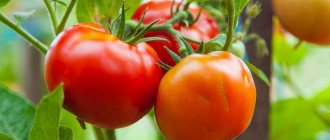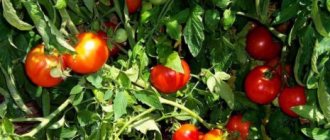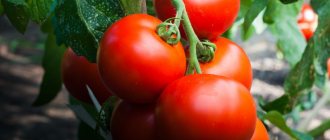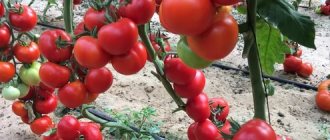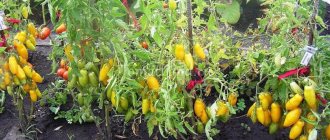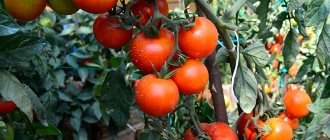The tomato variety with an interesting name is barely twenty years old, but Wild Rose tomatoes are already well known in all regions of the country, and they are also loved by gardeners from nearby neighboring countries. The Wild Rose tomato was bred and registered in Russia; it was presented as a productive and unpretentious variety with large pink fruits. The opinions and reviews of those gardeners who have already planted this variety on their plots are ambiguous, but this tomato definitely requires attention.
This article will be about the yield of the Wild Rose tomato, its characteristics and cultivation features. Here you can also find photos of the fruits and reviews from gardeners about this controversial variety.
Characteristics and description of the variety
The species is indeterminate, height 1.7-2.5 m. Spreading bushes, strong foliage . The first fruiting cluster is laid above the 9th leaf. 4-9 fruits are formed on each brush.
Reference! Indeterminate varieties do not have natural restrictions on shoot growth. To limit the growth of the plant, it is pinched.
An early ripening variety , 90 days pass from the emergence of seedlings to full ripening.
Productivity is high, from 1 sq. m, 6-7 kg of vegetables are collected , provided that no more than 3 seedlings are planted per 1 sq. m. m.
There is increased resistance to tobacco mosaic and late blight.
Reference! Tobacco mosaic is a viral disease, while late blight is a fungal disease.
The variety is well adapted to high ambient temperatures and high salt content in the soil. Recommended for cultivation in open ground and in greenhouse conditions.
Requires constant pinching and obligatory garter.
Fruit characteristics
The fruits are large, weight 300-350 g, round in shape, pink in color . The peel is thin, the flesh is juicy. The taste is excellent, sweet with a slight hint of sourness. There are 4-6 seed chambers.
Tomatoes are not stored for a long time, so they are immediately processed or consumed fresh . This variety is not used for pickling, marinades and preservation, but it exhibits good taste in pastes, ketchups, and juices. And, of course, vegetables are ideal in a fresh salad, in hot and vegetable dishes and in baked dishes.
History of the variety
The history of the victorious march to the Wild Rose tomato beds began in 1997; it was bred in Russia, especially for our varied conditions. And it was named after the main character of the Brazilian TV series of the same name. The authorship belongs to 4 breeders who, under the leadership of Vladimir Kachainik, developed this variety, which has long been recognized as an achievement of breeders. Originators – seed and Pridnestrovian Research Institute of Agriculture.
Wild rose tomatoes are so successful that they are widespread not only in the countries of the former USSR, but are also grown on an industrial scale in Bulgaria, Serbia, Hungary and Slovakia. And all because of its unique qualities!
We will describe the advantages of the variety and the features of its cultivation in this article.
How to grow seedlings
Sowing begins 2 months before planting seedlings in the ground . But before sowing seeds in the ground, they undergo special training.
Seed preparation
To get the highest percentage of germination, you will need high-quality planting material . To do this, take a good look at the seeds that you are going to sow: they should be light in color and without visible damage. Empty seeds are determined by immersing them in a saline solution (1 teaspoon of salt dissolved in a glass of water) for 10 minutes. Those seeds that float to the surface are not suitable for planting.
Disinfection of grains is carried out by immersion in a weak solution of potassium permanganate for 20 minutes . Then they are washed with running water, dried and soaked for 10-12 hours in a growth stimulator to improve germination.
Important! If you sow sprouted seeds, this will increase the germination percentage. The grains are wrapped in gauze, moistened with warm, at least 25 degrees, water and left in a dark and warm place for 2-3 days. After the sprouts appear, the seeds are sown in the ground.
Preparing the container and soil
Suitable soil is a mixture of garden soil with humus . It is light and fertile, which fully meets the requirements of the variety. Before sowing, the soil mixture is disinfected by pouring a solution of potassium permanganate or copper sulfate. You can plant them either in a common wooden box or in individual containers such as disposable plastic cups and peat pots.
Sowing
The seeds are sown slightly deeper and then sprinkled with a small amount of peat . The earth is moistened with a spray bottle and the planting containers are covered with film or glass to create a greenhouse effect. Then the containers are left in a dark and warm room, at a temperature of at least 22 C.
Growing and care
When the first shoots appear, the containers are placed in a well-lit place , but not in direct sunlight.
Caring for seedlings involves moderate watering as the top layer of soil dries out . Water with a small watering can or tablespoon with warm, settled water.
When 2 true leaves appear, the seedlings are picked and planted in separate containers.
During picking, the first fertilizing is carried out with complex mineral fertilizer . The same fertilizing is repeated before planting the seedlings in a permanent place.
Reference! Picking promotes the development of the root system and the proper growth of bushes.
Young bushes need warmth and periodic ventilation . But there is no need to create drafts, since drafts interfere with full development.
2 weeks before planting the seedlings in the ground, they are hardened off . The seedlings are taken outside for 2-3 hours, gradually increasing the time spent in the open air. The night temperature in the room where the seedlings are brought is reduced to 13 C.
➽ Tomato seedlings “Wild Rose”
Features of cultivation, planting and care
We recommend sowing the seeds of this tomato for seedlings 60-65 days before the intended planting in the ground. Picking - at the stage of 2 true leaves. When transplanting seedlings to a permanent place, 1 sq. m it is recommended to place up to 3 plants, and when forming into 1 stem - up to 4.
Further care for tomatoes consists of timely watering, weed removal, fertilizing with complex mineral fertilizer, pinching and preventive measures to protect the crop from diseases and pests.
When growing tomatoes in a greenhouse, we recommend installing a drip irrigation system - this will save your time and effort, as well as increase plant productivity and reduce the risk of late blight.
How to grow tomatoes
After 60 days, the young bushes are ready for transplanting . They can be planted in a greenhouse in mid-May; they are transplanted into open ground when the threat of night frosts has passed and the ground has completely warmed up.
Landing
Planting pattern : 50 cm – distance between seedlings, 60 cm – between rows.
A small amount of ash or complex fertilizer is added to each hole . After transplantation, the seedlings are not watered for the first week, so they adapt to the new conditions. If plants are watered immediately after planting in the ground, they will not absorb moisture, which will lead to rotting of the roots.
Tomato care
After each watering, the soil is loosened and hilled up .
This improves soil breathability and promotes full plant growth. Mulching with straw retains moisture in the beds, so the amount of watering can be reduced. But not in hot weather - during this period, on the contrary, they water more often. The frequency of watering is no more than 2 times a week, and on hot and dry days 3-4 times. Water with warm, settled water at the roots of the plants. You can install drip irrigation using an ordinary plastic bottle without a bottom. It is buried next to the root system, filled with water, and the moisture gradually penetrates to the roots.
Feed the tomato once every 14 days with a complete complex fertilizer or organic matter . Bird droppings are used as organic matter, which is diluted in a ratio of 1:10. Such a strong dilution is explained by the fact that a highly concentrated solution can cause a burn to the root system.
Reference! It is not recommended to fertilize tomatoes with fresh manure, since it promotes the growth of green mass, while the developing fruits do not receive the required amount of nutrients.
Features of cultivation and possible difficulties
The culture needs constant pinching of bushes . The plant is grown in 1 or 2 stems. This technique increases the quantitative indicator of fruiting. The lower leaves must be removed. Otherwise, they will rot from moisture in the beds, and fungus will appear.
Gartering a tall crop is another important step in tomato care . The support is installed next to each seedling immediately after planting them in the ground. The support is provided by wooden stakes or metal rods, to which young bushes are immediately tied. Early garter ensures the formation of a strong and even stem.
Diseases and pests
Infections and pests rarely affect Wild Rose , but the risk of crop disease should never be neglected.
Preventative actions are an effective method of maintaining plant health . Fungus prevention includes regular loosening, hilling the beds, removing weeds with roots and mulching the soil. Weeds hide many pests that spread to any crops, causing them harm. Loosening the soil prevents the penetration of insects that move underground and damage the root system, and mulch protects against slugs, preventing them from getting on the bushes.
Another effective preventive measure is an annual change of the top layer of soil, especially when it comes to a greenhouse . The new top layer of soil is disinfected with a weak solution of potassium permanganate to destroy pathogenic flora.
Planting fragrant herbs next to tomatoes prevents the appearance of parasitic butterflies.
Spraying seedlings with decoctions of onion peels, burdock, chamomile or weed infusion helps a lot . Treating the stems with soap root protects against aphids. Spraying with soda or vinegar helps against many flying and ground parasites.
Attention! In case of pest invasion, insecticides are used, for example, copper-containing ones like “Barrier”. But it is worth remembering that the use of chemistry is possible only before the crop begins to flower.
Growing technology
All actions that help to grow Wild Rose tomatoes should be performed carefully and carefully. If you make mistakes even in the simplest actions, you may not harvest the harvest or deteriorate its quality.
Watering
A distinctive feature of the Wild Rose tomato variety is that watering is very important for the bushes. The drip method of irrigating bushes is considered the most suitable, but if this is not possible, you can water it in a simple way.
It is recommended to water young bushes with tomatoes once a week, the amount of water is 1 liter per bush. Older plants should be watered on hot and dry days. If the weather is cloudy, watering can be done every 3 days.
Loosening and weeding
The Wild Rose tomato needs loosening and weeding. These actions are necessary to ensure that the plant receives enough air, which plays a big role in the growth and development of bushes. Loosening the soil is carried out along with its watering.
Weeds in the garden do not allow the bushes to develop, hide the plant from sunlight and can become a carrier of pests and diseases. For this reason, all weeds must be removed from the garden bed.
You can also mulch (cover) the bushes with straw. Straw is often used as a mulching material, which helps retain liquid in the beds. Straw-covered beds can be watered less frequently. However, in summer it is not recommended to resort to this procedure, since the frequency of watering in the summer should be increased.
Feeding
Tomatoes in a greenhouse can be fed with organic, mineral or complex fertilizers. Humus or compost are used as organic fertilizers. Mineral fertilizers include: superphosphate, urea, ammonium nitrate.
Complex fertilizers have also gained popularity among gardeners. Such products contain various mineral supplements that are beneficial for tomatoes and humus. Also, during the growing process, you can fertilize plants with products such as Epin, Zircon and Ovary. They belong to the means that stimulate the growth of roots and fruits.
Among the fertilizers intended for tomatoes, there are several of the highest quality products:
- Agricola is a mixture of powdered crystals. It must be dissolved in water and applied to the soil.
- Organic Mix is a complex of 17 components that are required by plants at all stages of growth and development. This type of feeding is distinguished by the fact that it dissolves slowly, enters the mail gradually and evenly saturates the roots with useful substances.
- Fertika Kristalon is a product that must be dissolved in water. It also contains all the components that members of the nightshade family need.
- Organic Mix Elixir is a natural fertilizer. The liquid fertilizer contains useful acids, amino acids and polysaccharides, which help increase productivity and accelerate plant growth.
Thinning
Since the leaves of the Wild Rose tomato are quite large, many leaves may appear on one bush. The emerging leaves may not allow sunlight to pass through, which is necessary for the fruits at the formation stage. In addition, dangerous pests may appear on the leaves. For this reason, tomatoes need thinning - it is necessary to remove the lowest leaves from the bushes.
Thinning bushes can also mean planting sprouts from a common box into separate boxes at the seedling stage. In a small box there will not be enough space for the bushes, so they should be divided into separate pots.
Bush formation
The formation of bushes includes several stages:
- Pruning - cutting off side shoots and shoots. It should be carried out no earlier than 14 days after the seedlings are transplanted to a permanent location. During these days the plant will take root and will easily tolerate this action. Such processes can be carried out either with scissors or with hands. The size of such stepsons should not exceed 7 cm.
- Pinching is an action aimed at limiting the growth of the main stem. The process is carried out early in the morning and involves removing the top of a soft shoot on a bush.
- Normalization of ovaries - cutting off too small or deformed fruit ovaries. This process is important because by examining the bush you can determine which ovaries will produce low-quality tomatoes.
- Tying - tying stems to posts or trellis. When giving the bushes additional support, you should not make hard knots so as not to damage the stem.
Pollination
Tomatoes can be pollinated either naturally or mechanically. To mechanically pollinate the bushes, you can knock on the branches. This will allow the pollen to land on the pistil. It is also important to monitor humidity: if the humidity is low, pollen will scatter and pollination will not occur.
The nuances of growing in open ground and in a greenhouse
The culture is recommended for cultivation in protected and unprotected soil .
But in those regions that have a short summer season, the seedlings are kept under film for the first two weeks. The shelter is removed gradually, but the covering material is not removed in case of unexpected cold weather. The Wild Rose tomato is able to grow and develop in highly saline soil .
This feature does not affect the yield. When planting in protected soil or open beds, do not thicken the bushes . The distance between seedlings should be such that each bush can receive the required amount of nutrients. Otherwise, a tall crop will not be able to fully grow and develop.
It is necessary to constantly tear off the lower leaves, otherwise they will rot from moisture in the beds . In addition, removing the lower leaves promotes better ventilation of the plants.
Greenhouses are regularly ventilated to eliminate the causes of many diseases . The influx of fresh air has a beneficial effect on the growth of bushes and destroys pathogenic flora.
About other varieties of tomatoes:
Growing tomato “Pink Miracle F1”
Tomato "Pink Paradise F1" from Japanese breeders
Wild rose tomatoes on video
If you grew Wild Rose tomatoes, please write whether you liked them or not. What was the yield and taste of the fruits like under your climatic conditions? How do you rate the disease resistance of this tomato variety? Briefly describe the advantages and disadvantages of tomatoes in your opinion. If possible, attach a photo of the entire bush or individual fruits you grew to your comment. Thank you!
Your reviews of the Wild Rose tomato and additions to the description will help many gardeners evaluate this variety more objectively and decide whether it is worth planting or not.
Harvesting and application
Harvesting begins 90 days after germination .
Since the variety is an early ripening variety, the fruits have time to ripen before the first frost in all regions. However, vegetables can be harvested unripe; at room temperature, the fruits ripen on their own in a few days. Since ripe vegetables cannot be stored for long, they are immediately processed or consumed fresh . They go into salads, hot dishes, stews, and perfectly complement the taste of other vegetables. Well suited for preparing tomato products - ketchups, pastes, juices. Since tomato products are paler than regular tomatoes, pink tomatoes are mixed with red ones to produce a rich color.
This variety is not used for pickling, marinades and canning..
Advantages
Reviews about the “Wild Rose” variety are quite mixed. Some gardeners cite a good harvest and excellent taste as advantages, while others, on the contrary, complain that the taste was not pleasing and that few tomatoes grew. Such statements should not be taken as truth; most likely, the problem lies in low-quality seeds, improper care and non-compliance with the recommended climate.
Read also: Fertilizer for onions and garlic
However, if we judge tomatoes in general, the advantages of this type include the fact that the variety does not react negatively to temperature changes. It will continue to grow in extreme heat, drought, and heavy rain. In general, it is not particularly demanding on the quality of the soil - the only thing recommended is regular feeding. This species can be successfully grown even on saline soils, which is not often found among tomatoes. “Wild rose” can be grown both outdoors and indoors, and, if necessary, “brought to fruition” indoors.
Good yield, good taste, visual attractiveness of the fruit - all this is also a plus factor. Finally, tomatoes tolerate transportation well.
Advantages and disadvantages of the variety
Culture has many positive aspects. The most important feature of pink tomatoes is their high content of vitamins . They are also widespread among allergy sufferers for whom the consumption of red tomatoes is contraindicated.
Other advantages of this culture:
- high fruiting rate;
- early ripening;
- high resistance to viral and fungal infections;
- unpretentiousness to soil composition;
- survival in soil with a high salt content;
- excellent taste of fruits;
- large vegetables.
Some negative aspects of the variety:
- requires constant stepsoning;
- requires mandatory garter;
- The quantity and quality of fruits depends on climatic conditions.
Advantages and disadvantages
| pros | Minuses |
| High sugar content | Garter required |
| Excellent taste | Need for light |
| Large fruit | The need to form a bush |
| Excellent immunity | Weak keeping quality |
| Not picky about the soil | Dependence of yield on weather |
| Drought resistance | Poor transportability |
| Resistance to hot weather | |
| Early maturation | |
| Marketability |
Farmer reviews
The review of this section will introduce you to the opinions of gardeners who grew the Wild Rose tomato variety. Despite a number of shortcomings, the crop is in considerable demand among experienced gardeners and lovers of pink fruits. Here are the opinions of summer residents:
Yuri, Zelenograd : “I really liked this variety. The tomatoes grew large, 400 grams or more each. This is the first time I have a variety with such a wonderful taste.”
Yulia, Tambov region : “I planted Wild Rose first in a greenhouse, then transferred it to the beds. Watered, fed, fed. I worked hard enough, this variety is not for lazy people. Thank God I wasn’t sick with anything. The harvest is good, I made excellent tomato juice. I'll definitely plant more. Very tasty tomatoes."
Pest and disease control
The Wild Rose tomato is distinguished by its resistance to viruses and fungi. But the gardener must carry out prevention. The procedure consists of preparing new soil for planting tomatoes. The soil is disinfected using a solution of potassium permanganate.
You can fight pests with a soap solution or ammonia. But you need to make sure that the mixture does not get into the soil. If the source of the problem is a spider mite, then insecticides are used for control, but only until the tomato begins to bloom.
Resistance to diseases and adverse conditions
The variety is resistant to many nightshade diseases, for example: tomato mosaic, verticillium and fusarium blight, cladosporiosis, bacterial wilt, blossom end and root rot.
But it is prone to late blight. This is a fungal disease. There are many reasons for its development: high humidity, low temperature, fog, the spread of fungus from the affected tops, frequent rains.
Signs:
- dark spots of a brown or grayish tint;
- rapid spread of stains;
- fluffy whitish coating;
- ugly deformation of fruits;
- active rotting of tomatoes, which is accompanied by an unpleasant odor.
How to fight?
Completely remove the bushes and burn them. The fungus spreads too quickly and even chemicals cannot cope with it (only slow it down). As a preventative measure, use fungicides and copper-containing preparations.
The Rose tomato suffers from aphids. Aphids, secreting liquid, attract ants, which only worsen the situation. How to fight? Buy larvae of beneficial insects (ladybugs, flies) at the store - they, as a rule, quickly cope with this pest. Bushes can be treated with chemicals, but only until the buds appear (“Aktara” does a good job of this task).
Thrips prevent seedlings from developing. These are pests no larger than 2 mm in size. They have a black elongated body, a striped belly and five pairs of legs. Their larvae are white or translucent.
Signs:
- multiplicity;
- increased activity;
- drink juices from tomato leaves;
- curvature of the tops and drying out;
- holes in leaves and fruits;
- the dying off of greenery and its further coloration in yellow.
They transmit diseases from different plants.
How to fight? Actively treat with insecticides. ATTENTION! Apply before fruit appears.
This variety is not afraid of unfavorable conditions, such as heat or sudden temperature changes.
Gardener mistakes
- Having set aside a poorly lit area for this variety, gardeners often end up with sour fruits. Only with an abundance of light do tomatoes acquire their best characteristics.
- Too dense a planting pattern and neglect of shaping leads to thickening of the beds, and this often ends in diseases and reduced yields.
- Excessive watering contributes to fungal diseases, especially if there is poor air circulation in the greenhouse. To control humidity, you need to focus on the condition of the soil, and after watering, ventilate the room and loosen the bed.
Landing
You can start sowing seedlings in March.
Before you start planting, you must carefully select seeds suitable for cultivation. For this:
- pay attention to the expiration date of the seeds (usually it is indicated on the back of the package and should not be more than 2 years);
- choose only a trusted manufacturer in a certified store (this will help you avoid purchasing low-quality products);
- pour the seeds, for example, into a cut glass and fill it with water;
- add a teaspoon of salt there without a lump and mix well;
- after 30 minutes, all low-quality seeds will certainly float to the surface;
- get rid of them, and place those remaining at the bottom on damp gauze;
- leave it for a few more days.
Once the seeds open and you notice green shoots on their surface, you can begin replanting into pots.
The seeds should not be immersed deeply - the maximum depth is 1 cm. The distance between the grooves is no more than 2. To create greenhouse conditions, cover the container with film. Check soil moisture daily. As soon as the first leaves appear, remove the film immediately, otherwise the seedlings may burn.
Keep watering it and wait for 3-4 leaves to appear. As soon as they are fully formed, begin to transplant them into different pots. When replanting, place the stem about a third into the ground (the guideline is the distance between the leaves and the ground is no more than 1 cm). This technique can strengthen the roots and prevent the bush from stretching out.
As the seedlings form:
- ensure the temperature is not lower than + 25 degrees;
- Using table lamps or special greenhouse lamps (phytolamps), provide the seedlings with at least 14 hours of daylight per day.
- do not let the soil dry out and do not try to over-moisten it;
- feed the sprouts with fertilizers, such as complex fertilizers;
- harden off daily by taking the pots outside or airing them.
After 15 days, feed with nitroammophoska. To do this, dissolve half a spoon of fertilizer in five liters of water. For one seedling no more than 100 ml. After 14 days, repeat the procedure.
If, after hardening, the leaves suddenly turn yellow, and under normal conditions they wrinkle, this directly indicates a lack of calcium. To replenish it, it is necessary to fertilize the bush with potassium monophosphate. This is easy to do: just scatter a small amount near the stem, first retreating a few centimeters, then loosen and water the tomato with Rose.
When the lower part of the leaf turns purple, the bush does not have enough phosphorus. To eliminate it, feed it with superphosphate.
To obtain a guaranteed high-quality harvest, you must:
- Feed tomatoes no more than 2-3 times a month.
Both complex fertilizers and nitrogen and potassium fertilizers are perfect for this. When purchasing, pay attention to the composition: it is worth purchasing fertilizers with the maximum content of phosphorus and potassium. Feeding is necessary at the stage of bush formation (discussed above), as well as at the stage of budding and formation of the vegetable. Do not forget to feed the seedlings a week after transplanting into the ground.
- Loosen the soil
An important and necessary procedure, especially after applying fertilizer. It helps not only to saturate the roots with air, but also ensures the best penetration of beneficial microelements and minerals into the bush. Loosening is also required after watering.
- Remove weeds
They can not only completely hide tomatoes from the sun, but also cause more serious and irreparable damage. Always keep your garden beds clean.
- Water
It seemed that it could be even simpler, but it is errors in watering that lead to the development of fungal diseases and death of the root system. Water strictly at the root, water should not get on the leaves. Ideal time: early morning before sunrise and late evening after sunset.
- Ventilate the greenhouse
It is extremely necessary to ventilate the greenhouse and monitor the temperature inside, because high humidity not only leads to the appearance of fungus, but can also completely destroy the bushes.
